2018 TOYOTA YARIS steering wheel
[x] Cancel search: steering wheelPage 3 of 632
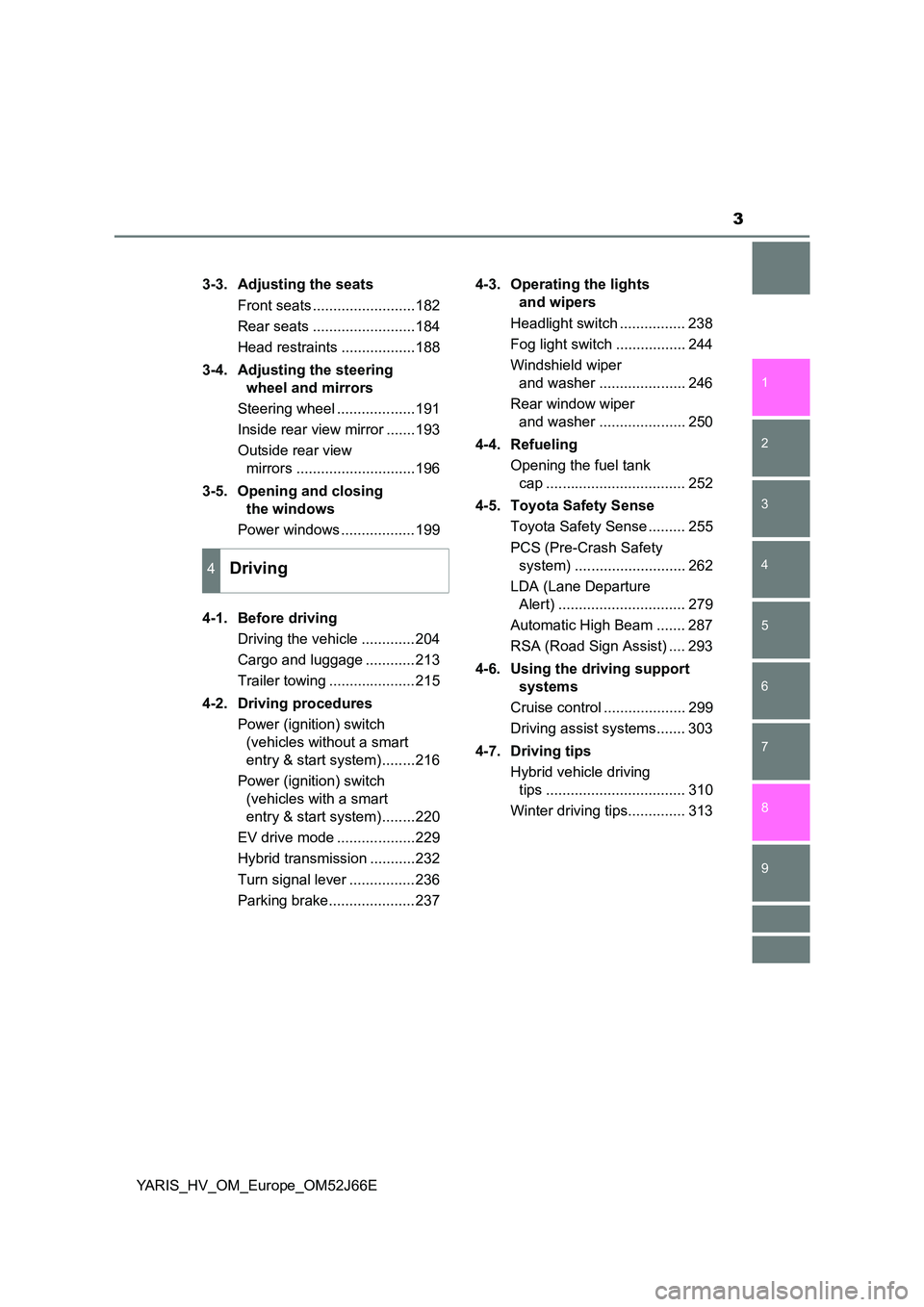
3
1
7
8
6
5
4
3
2
9
YARIS_HV_OM_Europe_OM52J66E
3-3. Adjusting the seats
Front seats .........................182
Rear seats .........................184
Head restraints ..................188
3-4. Adjusting the steering
wheel and mirrors
Steering wheel ...................191
Inside rear view mirror .......193
Outside rear view
mirrors .............................196
3-5. Opening and closing
the windows
Power windows ..................199
4-1. Before driving
Driving the vehicle .............204
Cargo and luggage ............213
Trailer towing .....................215
4-2. Driving procedures
Power (ignition) switch
(vehicles without a smart
entry & start system)........216
Power (ignition) switch
(vehicles with a smart
entry & start system)........220
EV drive mode ...................229
Hybrid transmission ...........232
Turn signal lever ................236
Parking brake.....................237
4-3. Operating the lights
and wipers
Headlight switch ................ 238
Fog light switch ................. 244
Windshield wiper
and washer ..................... 246
Rear window wiper
and washer ..................... 250
4-4. Refueling
Opening the fuel tank
cap .................................. 252
4-5. Toyota Safety Sense
Toyota Safety Sense ......... 255
PCS (Pre-Crash Safety
system) ........................... 262
LDA (Lane Departure
Alert) ............................... 279
Automatic High Beam ....... 287
RSA (Road Sign Assist) .... 293
4-6. Using the driving support
systems
Cruise control .................... 299
Driving assist systems....... 303
4-7. Driving tips
Hybrid vehicle driving
tips .................................. 310
Winter driving tips.............. 313
4Driving
Page 4 of 632
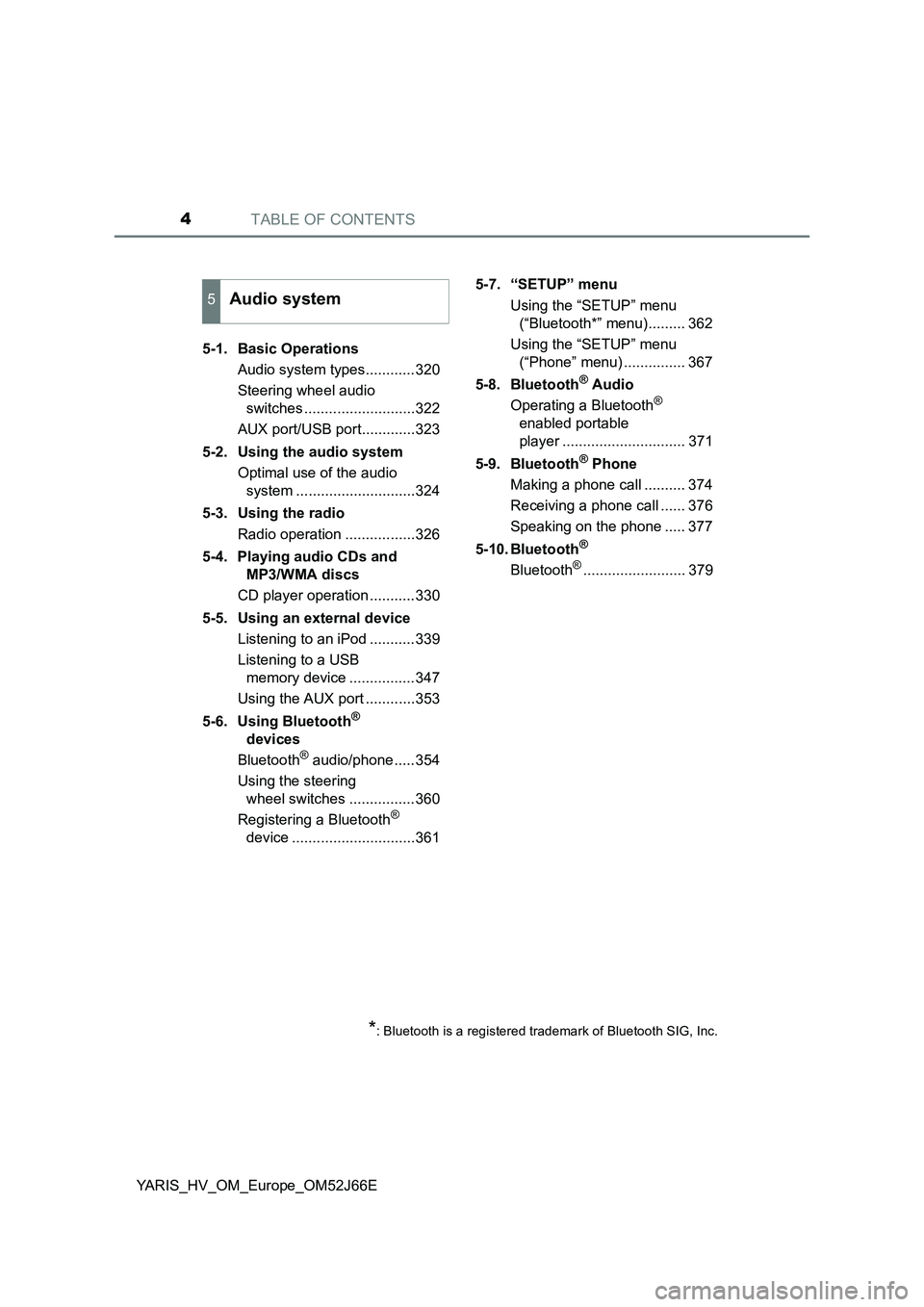
TABLE OF CONTENTS4
YARIS_HV_OM_Europe_OM52J66E
5-1. Basic Operations
Audio system types............320
Steering wheel audio
switches ...........................322
AUX port/USB port.............323
5-2. Using the audio system
Optimal use of the audio
system .............................324
5-3. Using the radio
Radio operation .................326
5-4. Playing audio CDs and
MP3/WMA discs
CD player operation ...........330
5-5. Using an external device
Listening to an iPod ...........339
Listening to a USB
memory device ................347
Using the AUX port ............353
5-6. Using Bluetooth®
devices
Bluetooth® audio/phone .....354
Using the steering
wheel switches ................360
Registering a Bluetooth®
device ..............................361
5-7. “SETUP” menu
Using the “SETUP” menu
(“Bluetooth*” menu)......... 362
Using the “SETUP” menu
(“Phone” menu) ............... 367
5-8. Bluetooth® Audio
Operating a Bluetooth®
enabled portable
player .............................. 371
5-9. Bluetooth® Phone
Making a phone call .......... 374
Receiving a phone call ...... 376
Speaking on the phone ..... 377
5-10. Bluetooth®
Bluetooth®......................... 379
5Audio system
*: Bluetooth is a registered trademark of Bluetooth SIG, Inc.
Page 34 of 632
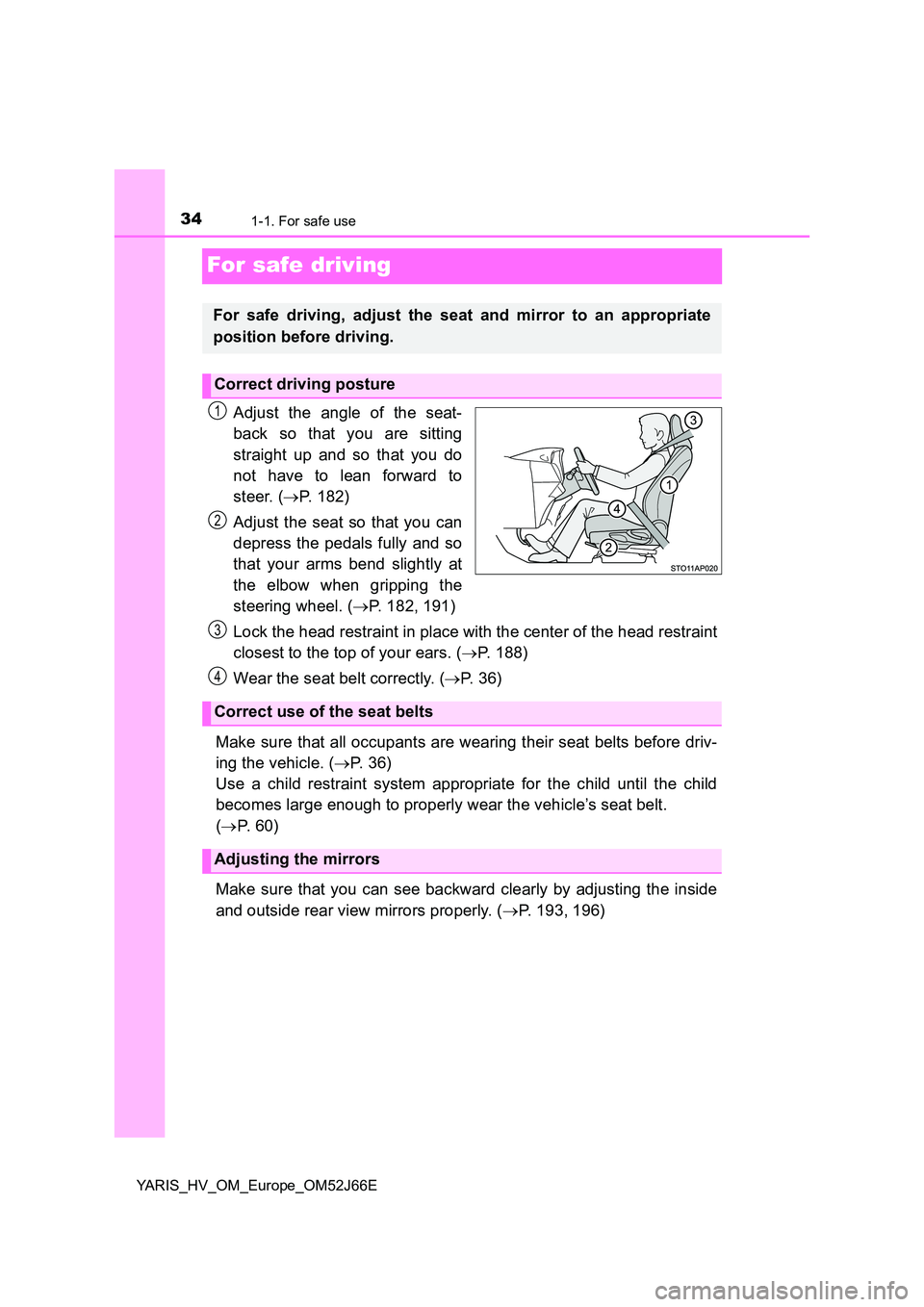
341-1. For safe use
YARIS_HV_OM_Europe_OM52J66E
For safe driving
Adjust the angle of the seat-
back so that you are sitting
straight up and so that you do
not have to lean forward to
steer. ( P. 182)
Adjust the seat so that you can
depress the pedals fully and so
that your arms bend slightly at
the elbow when gripping the
steering wheel. ( P. 182, 191)
Lock the head restraint in place with the center of the head restraint
closest to the top of your ears. ( P. 188)
Wear the seat belt correctly. ( P. 3 6 )
Make sure that all occupants are wearing their seat belts before driv-
ing the vehicle. ( P. 3 6 )
Use a child restraint system appropriate for the child until the child
becomes large enough to properly wear the vehicle’s seat belt.
( P. 6 0 )
Make sure that you can see backward clearly by adjusting the inside
and outside rear view mirrors properly. ( P. 193, 196)
For safe driving, adjust the seat and mirror to an appropriate
position before driving.
Correct driving posture
1
2
Correct use of the seat belts
Adjusting the mirrors
3
4
Page 45 of 632
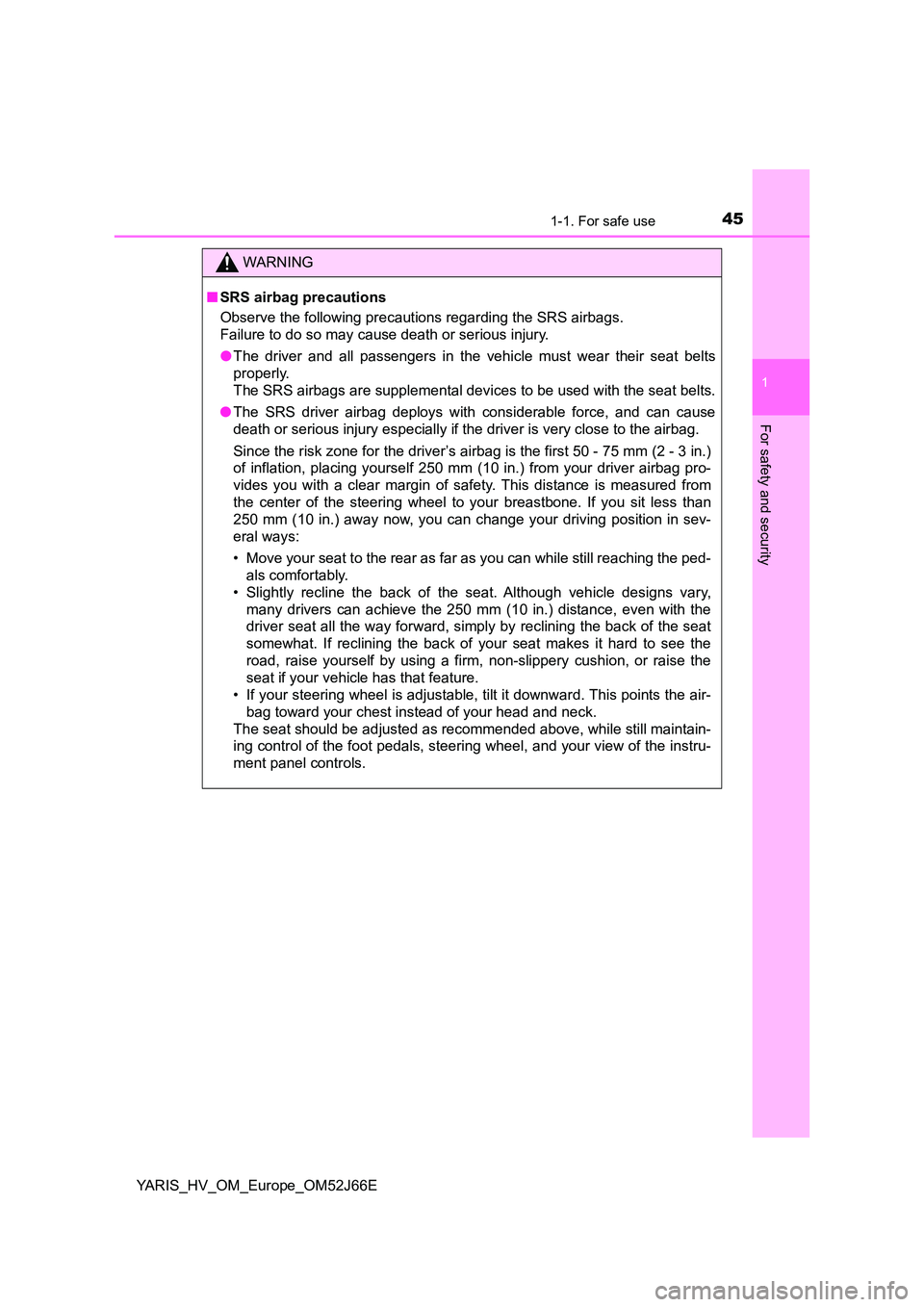
451-1. For safe use
1
For safety and security
YARIS_HV_OM_Europe_OM52J66E
WARNING
■SRS airbag precautions
Observe the following precautions regarding the SRS airbags.
Failure to do so may cause death or serious injury.
● The driver and all passengers in the vehicle must wear their seat belts
properly.
The SRS airbags are supplemental devic es to be used with the seat belts.
● The SRS driver airbag deploys with considerable force, and can cause
death or serious injury especially if the driver is very close to the airbag.
Since the risk zone for the driver’s airbag is the first 50 - 75 mm (2 - 3 in.)
of inflation, placing yourself 250 mm ( 10 in.) from your driver airbag pro-
vides you with a clear margin of safety. This distance is measured from
the center of the steering wheel to your breastbone. If you sit less than
250 mm (10 in.) away now, you can change your driving position in sev-
eral ways:
• Move your seat to the rear as far as you can while still reaching the ped-
als comfortably.
• Slightly recline the back of the seat. Although vehicle designs vary,
many drivers can achieve the 250 mm (10 in.) distance, even with the
driver seat all the way forward, simply by reclining the back of the seat
somewhat. If reclining the back of your seat makes it hard to see the
road, raise yourself by using a firm, non-slippery cushion, or raise the
seat if your vehicle has that feature.
• If your steering wheel is adjustable, tilt it downward. This points the air-
bag toward your chest instead of your head and neck.
The seat should be adjusted as recommended above, while still maintain-
ing control of the foot pedals, steering wheel, and your view of the instru-
ment panel controls.
Page 47 of 632
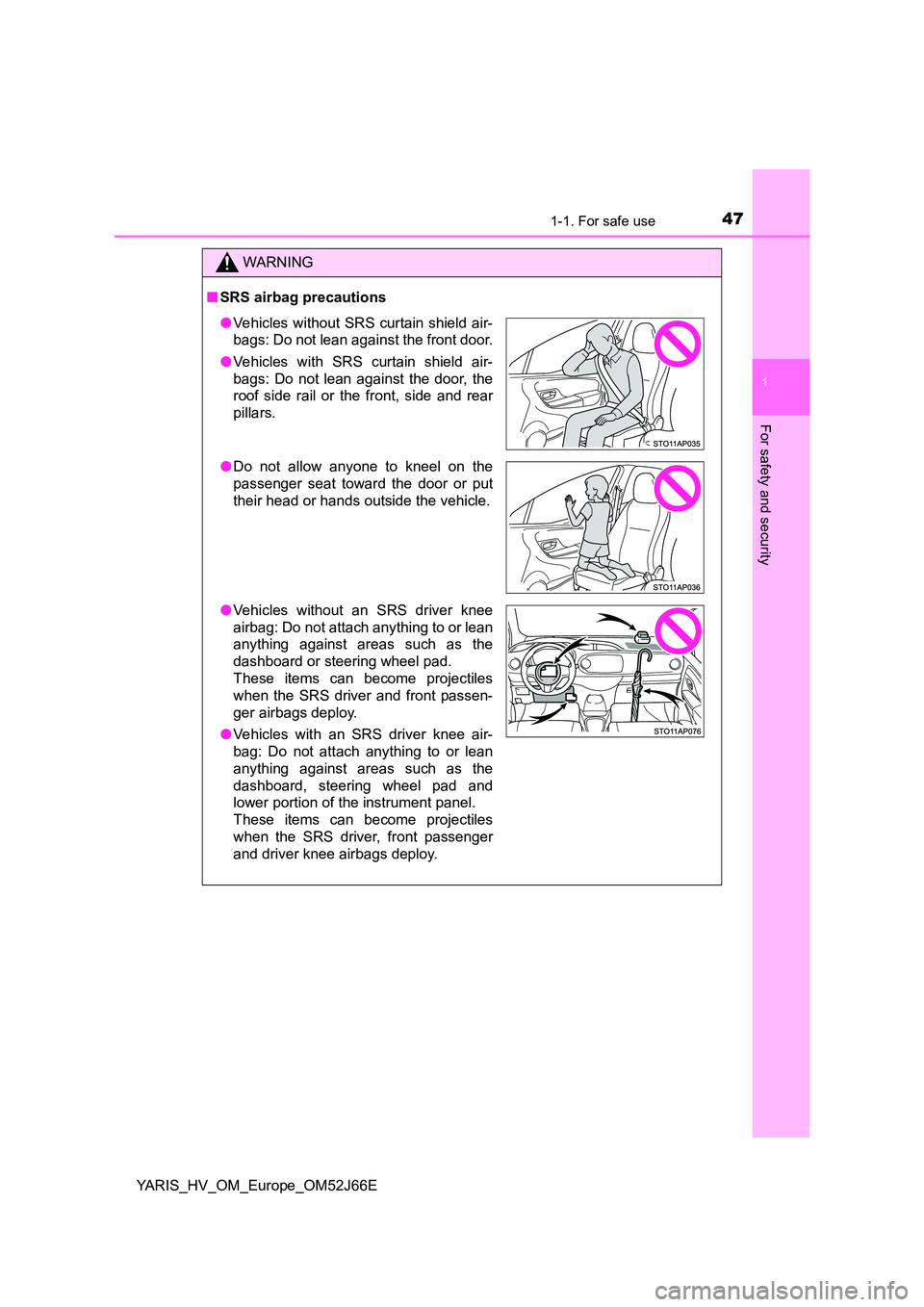
471-1. For safe use
1
For safety and security
YARIS_HV_OM_Europe_OM52J66E
WARNING
■SRS airbag precautions
●Vehicles without SRS curtain shield air-
bags: Do not lean against the front door.
● Vehicles with SRS curtain shield air-
bags: Do not lean against the door, the
roof side rail or the front, side and rear
pillars.
● Do not allow anyone to kneel on the
passenger seat toward the door or put
their head or hands outside the vehicle.
● Vehicles without an SRS driver knee
airbag: Do not attach anything to or lean
anything against areas such as the
dashboard or steering wheel pad.
These items can become projectiles
when the SRS driver and front passen-
ger airbags deploy.
● Vehicles with an SRS driver knee air-
bag: Do not attach anything to or lean
anything against areas such as the
dashboard, steering wheel pad and
lower portion of the instrument panel.
These items can become projectiles
when the SRS driver, front passenger
and driver knee airbags deploy.
Page 49 of 632
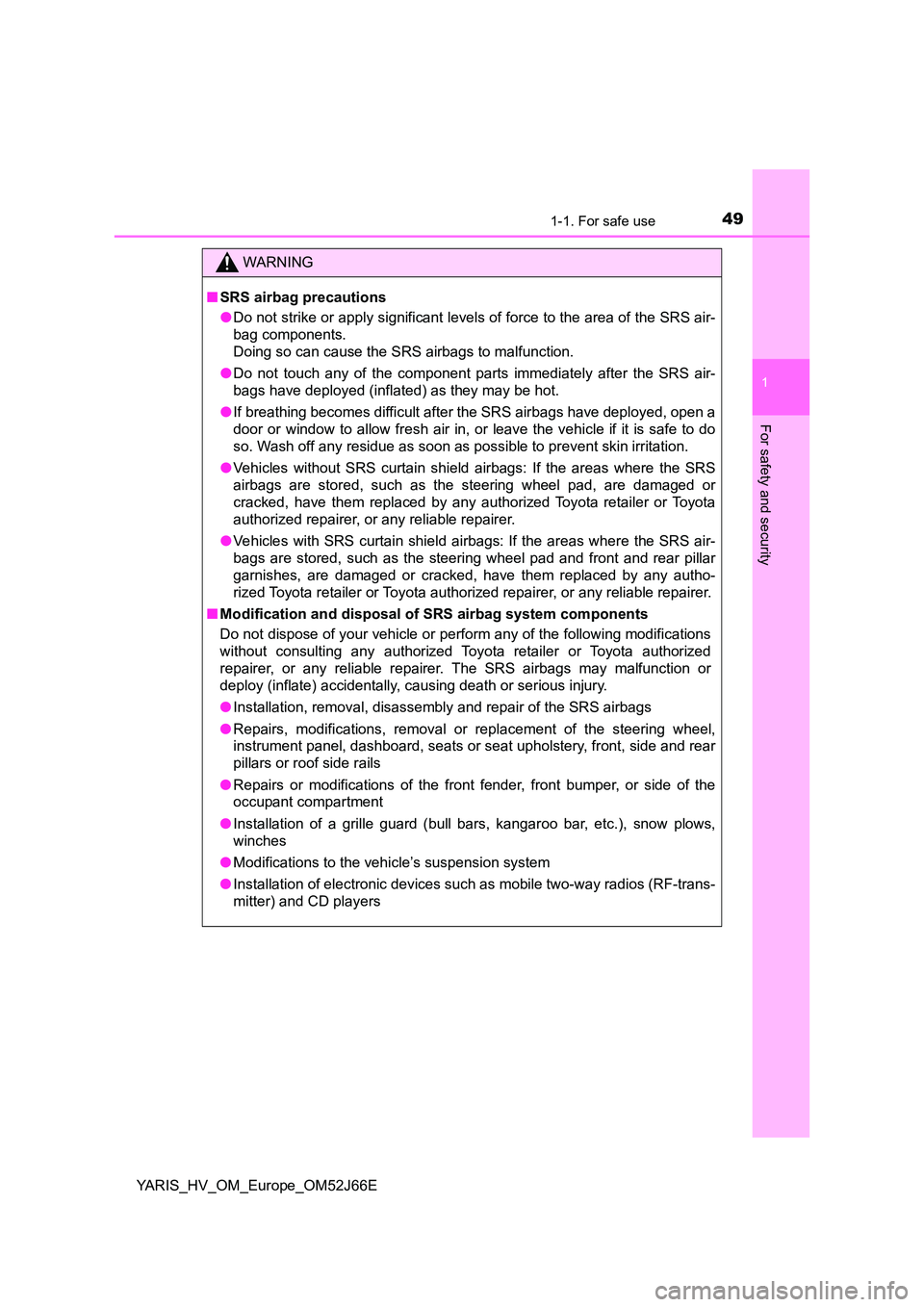
491-1. For safe use
1
For safety and security
YARIS_HV_OM_Europe_OM52J66E
WARNING
■SRS airbag precautions
● Do not strike or apply significant levels of force to the area of the SRS air-
bag components.
Doing so can cause the SRS airbags to malfunction.
● Do not touch any of the component parts immediately after the SRS air-
bags have deployed (inflated) as they may be hot.
● If breathing becomes difficult after the SRS airbags have deployed, open a
door or window to allow fresh air in, or leave the vehicle if it is safe to do
so. Wash off any residue as soon as possible to prevent skin irritation.
● Vehicles without SRS curtain shield airbags: If the areas where the SRS
airbags are stored, such as the steering wheel pad, are damaged or
cracked, have them replaced by any authorized Toyota retailer or Toyota
authorized repairer, or any reliable repairer.
● Vehicles with SRS curtain shield airbags: If the areas where the SRS air-
bags are stored, such as the steeri ng wheel pad and front and rear pillar
garnishes, are damaged or cracked, have them replaced by any autho-
rized Toyota retailer or Toyota authorized repairer, or any reliable repairer.
■ Modification and disposal of SRS airbag system components
Do not dispose of your vehicle or perform any of the following modifications
without consulting any authorized Toyota retailer or Toyota authorized
repairer, or any reliable repairer. The SRS airbags may malfunction or
deploy (inflate) accidentally, causing death or serious injury.
● Installation, removal, disassembly and repair of the SRS airbags
● Repairs, modifications, removal or replacement of the steering wheel,
instrument panel, dashboard, seats or seat upholstery, front, side and rear
pillars or roof side rails
● Repairs or modifications of the front fender, front bumper, or side of the
occupant compartment
● Installation of a grille guard (bull bars, kangaroo bar, etc.), snow plows,
winches
● Modifications to the vehicle’s suspension system
● Installation of electronic devices such as mobile two-way radios (RF-trans-
mitter) and CD players
Page 50 of 632
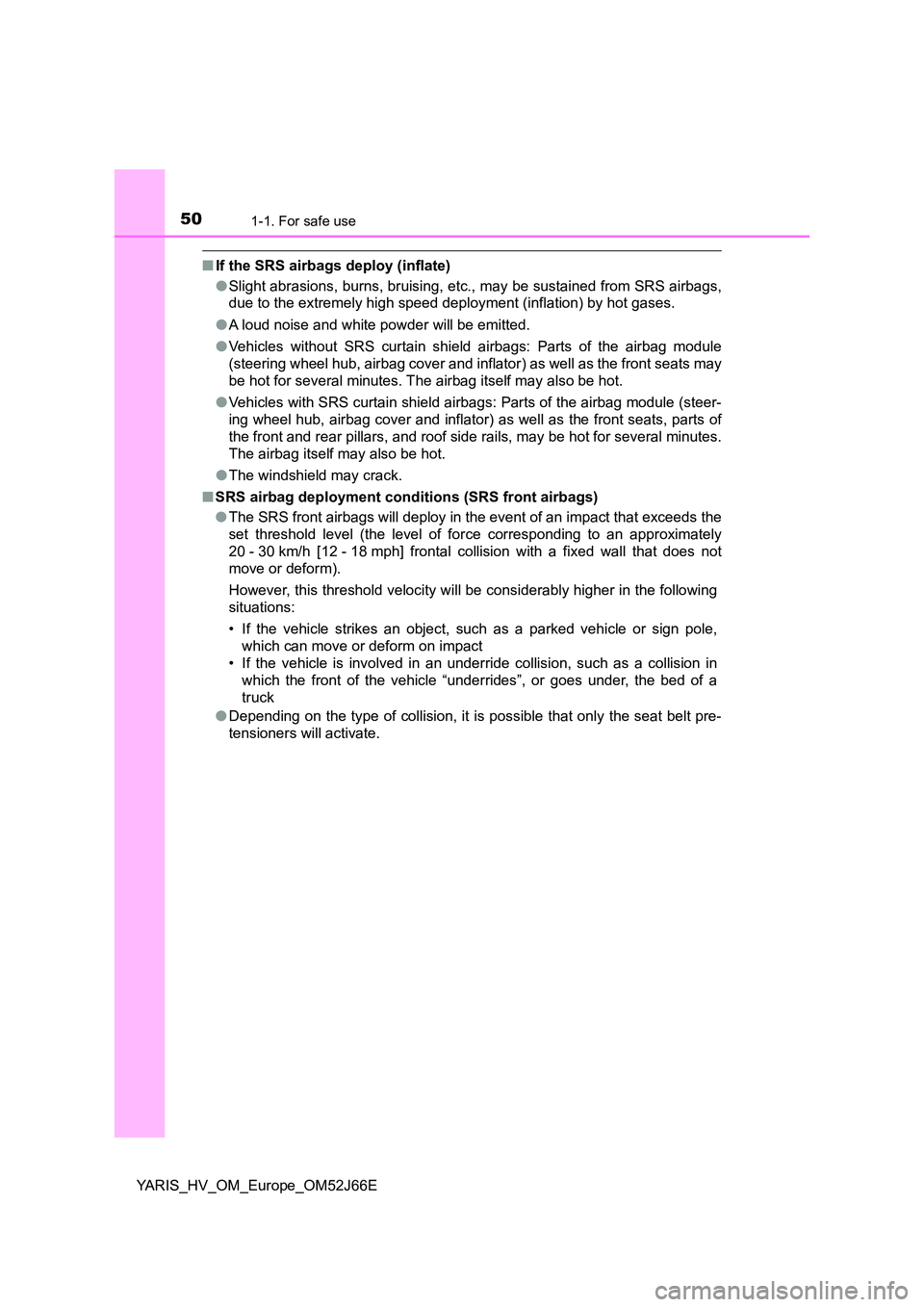
501-1. For safe use
YARIS_HV_OM_Europe_OM52J66E
■If the SRS airbags deploy (inflate)
● Slight abrasions, burns, bruising, etc., may be sustained from SRS airbags,
due to the extremely high speed deployment (inflation) by hot gases.
● A loud noise and white powder will be emitted.
● Vehicles without SRS curtain shield airbags: Parts of the airbag module
(steering wheel hub, airbag cover and inflator) as well as the front seats may
be hot for several minutes. The airbag itself may also be hot.
● Vehicles with SRS curtain shield airbags: Parts of the airbag module (steer-
ing wheel hub, airbag cover and inflator) as well as the front seats, parts of
the front and rear pillars, and roof side rails, may be hot for several minutes.
The airbag itself may also be hot.
● The windshield may crack.
■ SRS airbag deployment conditions (SRS front airbags)
● The SRS front airbags will deploy in the event of an impact that exceeds the
set threshold level (the level of force corresponding to an approximately
20 - 30 km/h [12 - 18 mph] frontal collision with a fixed wall that does not
move or deform).
However, this threshold velocity will be considerably higher in the following
situations:
• If the vehicle strikes an object, such as a parked vehicle or sign pole,
which can move or deform on impact
• If the vehicle is involved in an underride collision, such as a collision in
which the front of the vehicle “underrides”, or goes under, the bed of a
truck
● Depending on the type of collision, it is possible that only the seat belt pre-
tensioners will activate.
Page 53 of 632
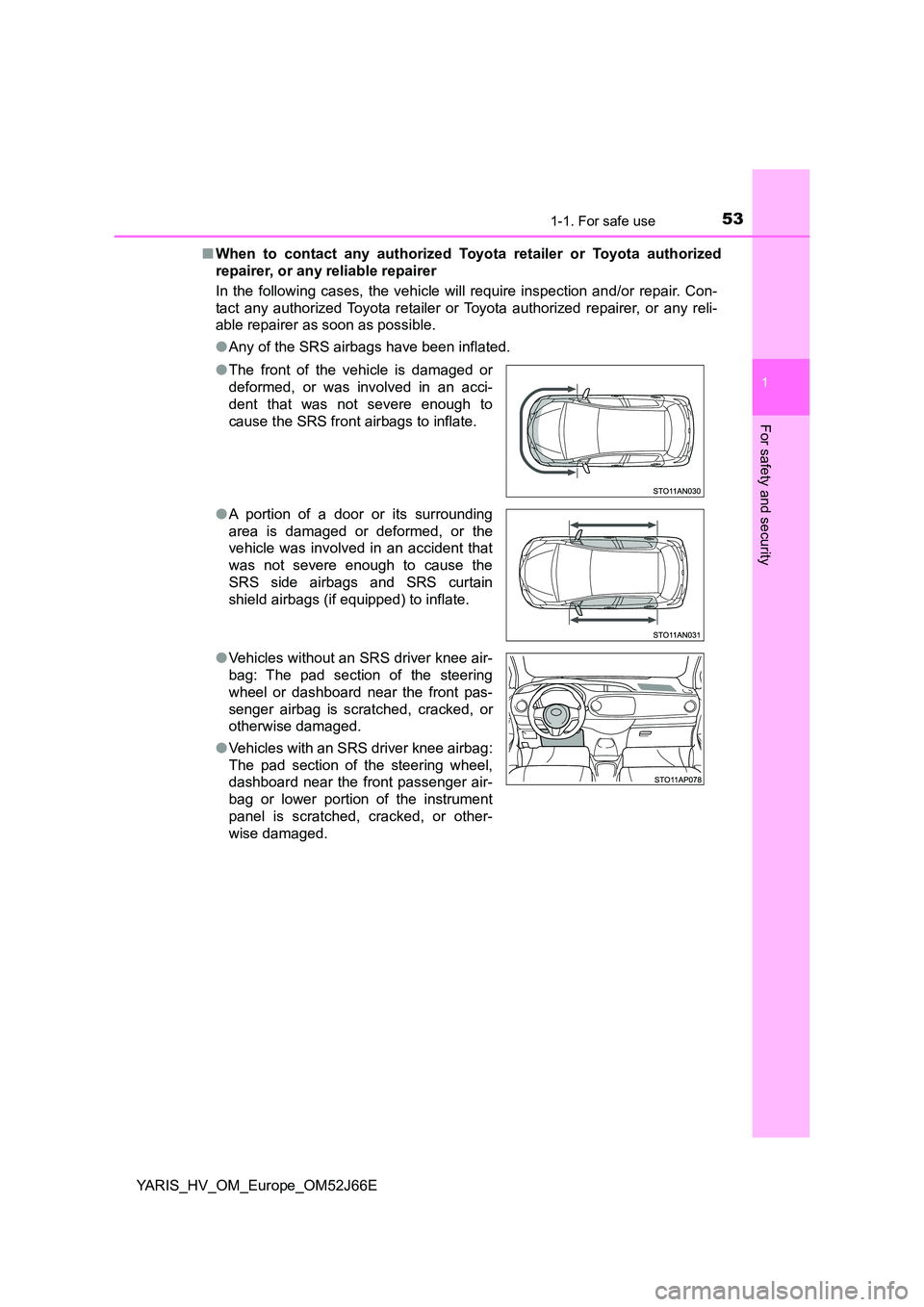
531-1. For safe use
1
For safety and security
YARIS_HV_OM_Europe_OM52J66E
■ When to contact any authorized Toyota retailer or Toyota authorized
repairer, or any reliable repairer
In the following cases, the vehicle will require inspection and/or repair. Con-
tact any authorized Toyota retailer or Toyota authorized repairer, or any reli-
able repairer as soon as possible.
● Any of the SRS airbags have been inflated.
● The front of the vehicle is damaged or
deformed, or was involved in an acci-
dent that was not severe enough to
cause the SRS front airbags to inflate.
● A portion of a door or its surrounding
area is damaged or deformed, or the
vehicle was involved in an accident that
was not severe enough to cause the
SRS side airbags and SRS curtain
shield airbags (if equipped) to inflate.
● Vehicles without an SRS driver knee air-
bag: The pad section of the steering
wheel or dashboard near the front pas-
senger airbag is scratched, cracked, or
otherwise damaged.
● Vehicles with an SRS driver knee airbag:
The pad section of the steering wheel,
dashboard near the front passenger air-
bag or lower portion of the instrument
panel is scratched, cracked, or other-
wise damaged.